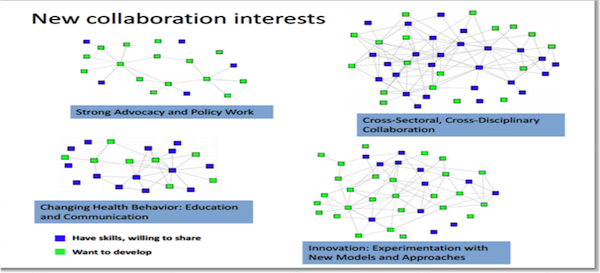Hi, I’m Rebecca Woodland, an Associate Professor of Educational Leadership at UMass Amherst. If there is one thing that I know for certain it’s that relationships matter and how we are connected influences the quality and outcomes of our shared endeavors. Social Network Analysis (SNA) has had a profound influence on my evaluation work. I want to introduce and encourage evaluators (who may not know much about SNA) to consider integrating it into their own practice.
Simply put, SNA is all about telling the story of how “ties” between people or groups form, and how these “links” may influence important program objectives and outcomes. With SNA you can mathematically describe and visually see connections between people. You can use SNA to explain and predict how ties between “actors” influence the attainment of program goals.
Hot Tips: Evaluators can use SNA to address a wide-range of pressing program evaluation questions such as these:
- Want to know whether a program has the capacity to spread a new or novel intervention? SNA was used to evaluate school-level capacity to support or constrain instructional innovation.
- Want to know how large, inter-agency partnerships develop and how inter-agency collaboration correlates with intended program outcomes? Evaluators used SNA to track the development and impact of a Safe Schools/Healthy Students inter-agency community mental health network.
- Want to know who influences the budgeting and disbursement of funds for advocacy programs in fragile environments? SNA was used to map the flow of resources and funding patterns for new-born survival activities in northern Nigeria.
Lesson Learned: Possibly the biggest wow factor is that SNA enables the creation of illustrative visuals that display complex information, such as intra-organizational communication flow and the location of network “brokers,” “hubs,” “isolates” and “cliques”, in user-friendly ways.
 Image via under Creative Commons Attribution 3.0 License
Image via under Creative Commons Attribution 3.0 License
Rad Resources
- ®Visualyzer is an easy to use program (with a 30-day free trial) that enables you to create socio-grams on any network of interest to you.
- The SAGE Handbook of Social Network Analysis. An outstanding guide to all aspects of SNA, including Chapter 38 which provides a comprehensive overview of SNA data collection and analysis software.
- The International Network of SNA (INSNA) has links to journals and to topical areas of interest.
The American Evaluation Association is celebrating Social Network Analysis Week with our colleagues in the Social Network Analysis Topical Interest Group. The contributions all this week to aea365 come from our SNA TIG members. Do you have questions, concerns, kudos, or content to extend this aea365 contribution? Please add them in the comments section for this post on the aea365 webpage so that we may enrich our community of practice. Would you like to submit an aea365 Tip? Please send a note of interest to aea365@eval.org. aea365 is sponsored by the American Evaluation Association and provides a Tip-a-Day by and for evaluators.
